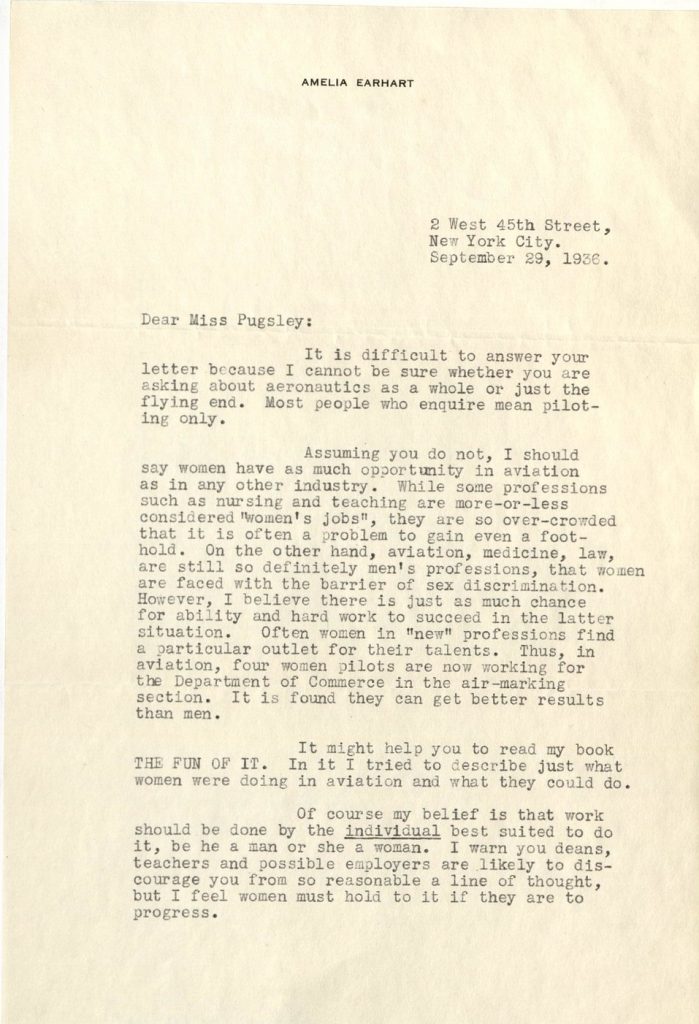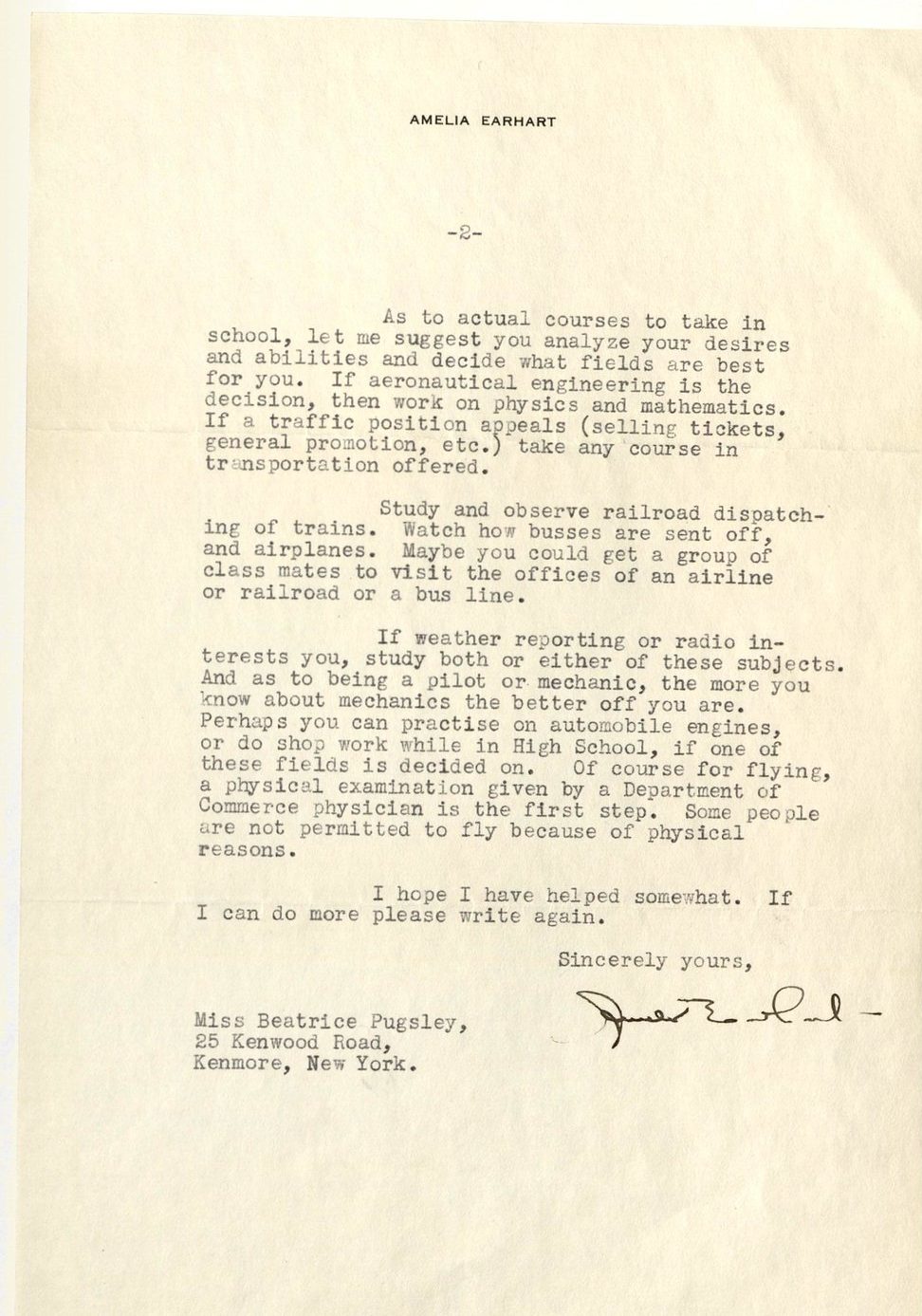Home / Confidence and Crises, 1920-1948 / The Great Depression / Aspirations and Career Goals
Resource
Aspirations and Career Goals
Amelia Earhart’s advice to a young aspiring adventurer.
- About
-
Curriculum
- Introduction
-
Units
- 1492–1734Early Encounters
- 1692-1783Settler Colonialism and the Revolution
- 1783-1828Building a New Nation
- 1828-1869Expansions and Inequalities
- 1832-1877A Nation Divided
- 1866-1898Industry and Empire
- 1889-1920Modernizing America
- 1920–1948Confidence and Crises
- 1948-1977Growth and Turmoil
- 1977-2001End of the Twentieth Century
- Discover
-
Search
Document Text |
Summary |
| 2 West 45th Street, New York City. September 29, 1936. |
Amelia Earhart’s address. |
| Dear Miss Pugsley: It is difficult to answer your letter because I cannot be sure whether you are asking about aeronautics as a whole or just the flying end. Most people who enquire mean piloting only. |
This letter is to a woman named Miss Pugsley. Amelia Earhart is not sure what type of work Miss Pugsley is asking about. But she will try to answer her questions. |
| Assuming you do not, I should say women have as much opportunity in aviation as in any other industry. While some professions such as nursing and teaching are more-or-less considered “women’s jobs”, they are so over-crowded that it is often a problem to gain even a foothold. On the other hand, aviation, medicine, law, are faced with the barrier of sex discrimination. However, I believe there is just as much chance for ability and hard work to succeed in the latter situation. Often women in “new” professions find a particular outlet for their talents. Thus, in aviation, four women pilots are now working for the Department of Commerce in the air-marking section. It is found they can get better results than men. | Creating a career in aviation is like creating a career in many other fields. It can be difficult to find a job in traditional women’s fields like nursing and teaching because so many women want to work in those fields. On the other hand, finding a job in a traditional men’s field is also hard. Women face sex discrimination in areas like aviation, medicine and law. Amelia feels strongly that if women work hard they can success in men’s fields. There are four women pilots working for the government because they proved they could do it. |
| It might help you to read my book THE FUN OF IT. In it I tried to describe just what women were doing in aviation and what they could do. | Amelia recommends reading her book called The Fun of It for more information. |
| Of course my belief is that work should be done by the individual best suited to do it, be he a man or she a woman. I warn you deans, teachers and possible employers are likely the discourage you from so reasonable a line of thought, but I feel women must hold to it if they are to progress. | Amelia believes that jobs should go to the most qualified individuals, regardless of gender. Teachers and school administrators might discourage women students, but women must not give up. |
| As to actual courses to take in school, let me suggest you analyze your desires and abilities and decide what fields are best for you. If aeronautical engineering is the decision, then work on physics and mathematics. If a traffic position appeals (selling tickets, general promotion, etc.) take any course in transportation offered. Study and observe railroad dispatching of trains. Watch how busses are sent off, and airplanes. Maybe you could get a group of class mates to visit the offices of an airline or railroad or a bus line. |
Amelia suggests that Miss Pugsley think about which careers match her skills and interest. If Miss Pugsley wants to work in aeronautical engineering, she should take math and physics classes. If she wants to work in traffic control, she should study transportation. |
| If weather reporting or radio interests you, study both or either of these subjects. And as to being a pilot or mechanic, the more you know about mechanics the better of you are. Perhaps you can practice on automobile engines, or do shop work while in High School, if one of these fields is decided on. Of course for flying, a physical examination given by a Department of Commerce physician is the first step. Some people are not permitted to fly because of physical reasons. | If she wants to work in radio or weather, she should take classes related to these topics. If she wants to be a pilot or mechanic, she should learn how machines and cars work. If she wants to be a pilot, she should have a government doctor confirm that she is healthy. Some people cannot fly for health reasons. |
| I hope I have helped somewhat. If I can do more please write again. Sincerely yours, Amelia Earhart |
Amelia hopes this letter was helpful and offers to reply to future questions. |
| Miss Beatrice Pugsley 25 Kenwood Road Kenmore, New York. |
Miss Beatrice Pugsley’s address. |
“Amelia Earhart to Miss Pugsley,” Sept. 1, 1936. Schlesinger Library, Harvard University.
Background
The Great Depression halted many women’s dreams. But the Jazz Age ideals of self-expression and independence were not totally gone. Many young women still dreamed of higher education, a career, and a life outside of marriage and other traditional gender roles. In addition, women (and men) were inspired by the stories of adventure seekers who escaped the confines of economic depression.
Starting a career in a new field was daunting for all people in during the Great Depression, but women faced particularly challenging barriers. Jobs were defined by clear gender lines. Teaching, nursing, social work, and some areas of social science research were acceptable women’s fields. Anything else was still traditionally considered men’s work. Relatively new fields like aeronautics and navigation that included technology, mechanics, and engineering were particularly dominated by men.
About the Document
This is a letter from Amelia Earhart to Beatrice Pugsley. Amelia Earhart was one of the most famous women in the world when she wrote this letter. In 1932, she was the first woman to fly solo across the Atlantic Ocean, completing the flight in fifteen hours. She was also the first person to fly over both the Atlantic and Pacific Oceans. Amelia also served on the faculty of Purdue University where she counseled women students on their career options. She was probably preparing for her upcoming attempt to fly around the world when she wrote this letter. She attempted that impressive feat in July 1937, but tragically disappeared somewhere over the Pacific Ocean. Amelia Earhart was declared legally dead in 1939.
The letter suggests that Beatrice was a student who wrote to Amelia and asked for career advice. In her reply, Amelia did not merely offer practical advice for starting an aviation career. She also reflected on the challenges women faced in all professions, and expressed her belief that men and women have equal abilities.
Vocabulary
- aeronautics: The science of flying or traveling in the air.
- aviation: Flying or operating an aircraft or airplane.
- dean: The head of a college or department at a college.
- mechanic: Someone who studies or repairs the working parts of something.
- mechanics: The working parts of something.
- shop: A class in school that involves hands-on work with tools and mechanical items.
Discussion Questions
- How do you think Beatrice Pugsley felt receiving this letter and why?
- What are Amelia’s views on the state of women in the workplace? What challenges and opportunities do women face? How does Amelia feel about these?
- What practical advice does Amelia offer for starting an aviation career?
- Amelia ends the letter by offering to provide additional advice. Why is that significant? What might this tell us about her personality and her connection to female “fans”?
- To what extent does Amelia Earhart’s advice resonate with you as a student today?
Suggested Activities
- Historians often compare Amelia Earhart and Gertrude Ederle. Both women broke records and fought for recognition as women in fields dominated by men. Read Gertrude’s life story with this letter. How do you think Gertrude would react to Amelia’s advice and perspective? What do the two women have in common?
- Amelia began her career in the Jazz Age and continued to be famous into the Great Depression. Review materials relating to flappers in the media and in reality to consider how her career was shaped by the youthful ideals of the 1920s.
- Amelia describes the challenges of pursuing a career in this letter. Pair this resource with the life stories of Ellen Swallow Richards and Chien-Shiung Wu to broaden the conversation about women who worked in male-dominated fields.
- Discuss the importance of role models and encourage students to contact someone (via letter, email, social media) who represents a field or career they are considering. Ask students why studying and reaching out to role models is important—even if they aren’t lucky enough to receive a response.
Themes
SCIENCE, TECHNOLOGY, AND MEDICINE; AMERICAN IDENTITY AND CITIZENSHIP








